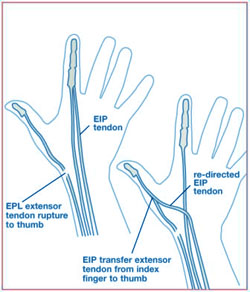 Tendon transfer surgery can be a very effective treatment for various conditions. It is used when muscle function is lost due to a nerve injury.
Tendon transfer surgery can be a very effective treatment for various conditions. It is used when muscle function is lost due to a nerve injury.
What is it?
The purpose of tendon transfer surgery is to improve the normal function of hands. This is accomplished by moving a working tendon from its original position to a new one in order to bring back lost functions.
What needs it?
Tendon transfer surgery can be a very effective treatment for various conditions. It is used when muscle function is lost due to a nerve injury. Nerves that have been injured lose the ability to control muscle movement. This procedure attempts to restore muscle control by replacing the damaged tendon with a healthy one.
Sufferers of rheumatoid arthritis or fractures are often treated with tendon transfer surgery. In addition, it may be used to repair a ruptured or lacerated muscle or tendon that cannot be fixed by other means.
Sometimes nervous system disorders may cause loss in muscle function, which also necessitates tendon transfer surgery. Symptoms associated with traumatic brain injuries, stroke, cerebral palsy, and spinal muscle atrophy can often be relieved through this surgery.
Occasionally, babies are born lacking some muscle functions. Common muscle-related birth defects include birth brachial plexopathy (nerve-related paralysis) and hypoplastic (underdeveloped) thumbs. Tendon transfer surgery has been shown to sometimes be effective at treating these conditions.
What is the procedure like?
There are more than 40 muscles between the elbow and the thumb and each one has a specialized function. For example, it takes 9 muscles just to move your thumb. Muscles go from their starting point (origin) into a tendon that joins the bone (insertion) at a given place. Body movements occur when a muscle fires (contracts) and gives a specific direction to that body part.
During the surgery, the muscle’s origin remains fixed, as do the nerve and blood supply to that muscle. The tendon insertion, however, is detached and sewn in at a different location. It may be sewn into a different tendon or into a different bone. In its new location, the tendon will produce the appropriate action when the muscle is fired.
What are some alternative treatments?
Other treatment options may be discussed with your surgeon. It’s possible that we may be able to repair the injured nerve, tendon or muscle. Sometimes, a tendon graft can be utilized to close the gap in the injured tendon. Tendon lengthening or bone fusions, in some cases, might be needed to restore healthy hand function.
What are the risks?
Although risk is minimal, all surgery comes with some risk and results in a scar. Infections can develop around the incision location. Anesthesia is required, as well as a thorough pre-op physical exam and medical history analysis. Your surgeon and anesthesiologist will evaluate your individual case to determine the best choice for you.
As with all surgeries, a tendon transfer will need time to heal, typically one to two months. A splint or cast might be employed. Additionally, exercises that strengthen the muscle and promote proper tendon function can be done with a physical therapist until the transferred tendon has fully healed. As premature movement can cause the tendon to rupture, it’s crucial that you follow post-op instructions with fidelity.


